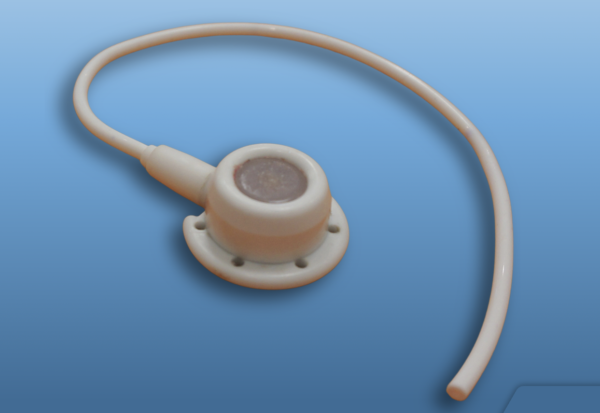
Our recently-concluded INVEST conference had a new take on our medical devices pitch track: This year we decided to tweak it to make it Remote Patient Monitoring and Smart Devices. The three judges — active investors from the traditional VC, corporate provider and corporate payer VC worlds — were so taken by two pitch presenters that they decided to name joint winners for the track. In alphabetical order, they are San Francisco-based Blumio and Saint Paul, Minnesota-based NxGenPort.
“At the highest level, we selected these companies because their products had the potential to addresses large unmet needs, and the founders articulated a well-reasoned business plan,” said Brett Cook, principal at F Prime and a judge, in an email after the conference. “Additionally, we liked the fact that the companies had a clear perspective on how reimbursement would work and how their solutions would fit into clinical workflows.”
Dipa Mehta, vice president of corporate venture capital and innovation at Advocate Aurora Health in Illinois, chimed in with: “Both companies also are in large markets (oncology and maternal health) with a clear view on reimbursement for their technologies.”
The third judge, Tom Olenzak, managing director of strategic investing at Independence Blue Cross, called out the skill of the presenters in his comments.
“Both of these companies had quite impressive CEOs who were able to succinctly define the company’s product and strategy,” Olenzak said.
Below are profiles of both companies:

A Deep-dive Into Specialty Pharma
A specialty drug is a class of prescription medications used to treat complex, chronic or rare medical conditions. Although this classification was originally intended to define the treatment of rare, also termed “orphan” diseases, affecting fewer than 200,000 people in the US, more recently, specialty drugs have emerged as the cornerstone of treatment for chronic and complex diseases such as cancer, autoimmune conditions, diabetes, hepatitis C, and HIV/AIDS.
Blumio
Founded in 2016 to develop a cuffless blood pressure monitor, the San Francisco startup has pivoted to managing hypertension in a focused market: pregnant women. Monitoring blood pressure is critically important in expectant mothers because of the complication of preeclampsia where high blood pressure and high levels of protein in urine cause negative effects on other organs and could be harmful to both mother and the fetus.
After analyzing what other companies had used — off-the shelf sensors — to develop their cuffless monitors, Blumio executives settled on radar technology, said Catherine Liao, co-founcer and CEO of the company, in a recent online video interview.
“The reason why we chose radar was that we understood that radar had been used in vital sign sensing in a hospital setting for quite a long time – typically aiming the radar at the chest wall and to get vital signs such as respiration rate and heart rate that way. And we asked the question — can you look at something closer and specifically can you see the pulsation of the arteries and give us something useful? Radar technology has advanced in such a way in the last couple of decades to a point where the radar system has been miniaturized. They operate very precisely and they can now delineate very very small motions from large motions.
In settling on radar, Blumio was also able to tap into a technology that Google and Infineon co-developed: a sensor chip that can understand gestures and that has found its way into the Google Pixel 4 smartphone.
“So we looked at that and said, ‘Great but can we get health metrics out of it?'” Liao recalled. “And so we partnered with Infineon to explore the use of their radar [to measure blood pressure] and started really finalizing a prototype. By the end of 2019, we had a working prototype with some preliminary validation.”
Last year, Blumio did a 120-subject study using the prototype system and published a paper on the accuracy of the system. Now the goal is to raise $8 million in a Series A round, having already raised $4.5 million ( of which $2.5 million is non-dilutive).
“In 2022 we are ready to take our prototype bench system and translate that into a clinical form factor that we can go into a more intensive clinical study for a FDA clearance,” Liao said.

What the Blumio cuffless blood pressure device will look like
The device will have a flexible base worn on the wrist to conform to the skin. The sensor can simply slide on to the device. The end user — in this case, the pregnant mother who is at risk of preeclampsia and has been prescribed the device made by Blumio — will wear it at night.
“High night-time blood pressure has been correlated with preeclampsia,” Liao said.
Blumio will not be the first company to bring a cuffless device on the market. Liao said she is aware of three companies that already have regulatory clearance in the U.S. and/or Europe — the BPro G2 wrist-worn device; the Biobeat Chest Monitor and the Aktiia device out of Switzerland. The first two have FDA clearance; Biobeat has CE Mark; while Aktiaa has CE Mark but is not FDA-cleared.
Not being first while not ideal is not the end of the world. In fact, Liao believes in getting it right than being the first.
“We’re still in the very early stages of a race as no cuffless device has actually captured a monitoring market — whether inpatient, remote patient monitoring (chronic disease management, pregnancy, and other segments), or consumer-facing,” she asserted. “On top of that, there’s no such thing as a ‘minimum viable medical device’ and it’s important that we take all the proper steps versus rushing something to market with a product that doesn’t work.”
NxGenPort
Based in Saint Paul, Minnesota, NxGenPort is aiming to bring remote patient monitoring to cancer patients receiving chemotherapy treatments. These patients are already implanted with a chemotherapy port, which is a small reservoir with a thin tube that is inserted into to a large vein in the heart to deliver drug therapy to patients. NxGenPort is adding optical sensors to transform such chemo ports into smart devices that can provide information oncologists need to decide whether the patient has recovered adequately for the next treatment.
“What we will be collecting is a robust data package — WBC count down to the five differential white blood cells, ejection fraction, which is a measurement of heart function, body temperature, oxygen level, and the combination of all those things helps oncologists make a go/no-go decision on treatment,” said Cathy Skinner, in a recent Zoom interview.
Often, cancer patients finish one treatment and if it doesn’t work in halting disease progression, oncologists must decide, based on lab work, whether a patient would be a good candidate for a different therapy or clinical trial. For that, patients have to typically go to the cancer clinic to get the blood work done. While NxGenPort is not looking to evaluate any treatment’s efficacy, Skinner wants to leverage remote patient monitoring to evaluate their health status. Instead of having patients go to a clinic, the smart port the company is developing can be used to WBC info. In other words, she is taking inconvenience out of the equation.
“So we are solving an unmet need in cancer care where between chemotherapy visits, cancer patients are unmonitored. And unmonitored in the sense that their blood cell counts and cell functions are not being tracked on a regular basis so patients have to go into clinic to have their blood cells tested before a treatment decision or intervention can be made,” she said.

NxGenPort
Aside from optical sensors, the smart chemo port leverages machine learning.
‘It’s hardware that has optical sensors and software with machine learning that says ‘that’s a red blood cell, that’s a white blood cell, that’s a red blood cell” she explained.
Ultimately, Skinner believes that the AI being developed would even go beyond distinguishing a WBC from a RBC. It will recognize five different white blood cells in the body: granulocytes (neutrophils, eosinophils, and basophils), monocytes, and lymphocytes (T cells and B cells)
“We are getting to the nuance of the 5 white blood cell differential, specifically to a cell called neutrophils, which is one of the definitive measures that an oncologist will give a go/no-go decision on doing the next chemo,” Skinner said.
The same information on WBC can drive interventions of a different nature. For instance, if a patient’s blood work shows a reduction in WBCs, the oncologist can ask the patient to come in for a blood transfusion or for a growth factor, Skinner. This can boost the WBC count.
The data on the different types of WBCs is a point of differentiation from competitors like San Francisco-based Oncodisc (now called Veris Health) , according to Skinner. Veris Health is also attempting to improve the lives of cancer patients through remote monitoring. It is developing an implantable vascular access device but the company tracks physiologic signs more broadly, such as body temperature and oxygen levels. It also has an accelerometer, Skinner said. Veris Health’s website and news releases did not contain more information about what specific data the smart vascular access port can gather.
Another company Leuko, based in Spain, is targeting cancer patients with a device that claims to be the first device for non-invasive white blood cell monitoring. PointCheck will be a table top device into which patients may insert their fingers. Leuko’s website says the technology works by “shining light into the skin surrounding the fingernail,” and through this PointCheck is “able to image the blood cells flowing through superficial capillaries.” The company’s proprietary machine learning algorithm can then determine “whether white blood cell levels are dangerously low.”
However, Skinner said that having a table top device might not be the most secure way to gather data on the wellbeing of cancer patients.
“There are competitors in the market that are building devices that are on someone’s coffee table and they have to stick their finger in the device to get their RBC and WBC. They don’t get to the nuance of the WBC differential that we do but anybody’s grandkid could stick their finger in the device and so by having it implanted in the body, we are offering another level of accuracy in terms of measuring the true person that we are collecting data on,” Skinner asserted.
Founded in 2020, NxGenPort has already been able to secure a knowhow license with the Mayo Clinic. Through this, NxGenPort has the ability to meet weekly with one of Mayo’s oncologists who can help them think through device development, data acquisition and workflow, among other things.
“In exchange for her knowhow Mayo holds some equity in the company,” Skinner said.
Around 19 million people globally are diagnosed with cancer annually and 10 percent of them are implanted with a chemotherapy port in their bodies, according to Skinner. The market is large and so is the potential for reimbursement should the smart port win FDA clearance.
There are about five different CPT codes that a hospital system would be able to leverage to win reimbursement, Skinner said. The NxGenPort device would cost $1,000 per device and include 12 months of remote monitoring data. In turn, hospitals would be able to bill for $2,400 a year for the device based on codes available, Skinner declared.
For now, she is looking to raise $1 million in a pre-seed round but ultimately plans to raise a $12 million seed round next year that will help to gather data needed for a de novo 510 (k) submission to the FDA for the hardware piece and a regular 510(k) for the software that is part of the platform.
“We are trying to change the paradigm for how treatment decisions are made and how scheduling and clinical visits occur,” she said.
Picture: Getty Images, Oat_Phawat













